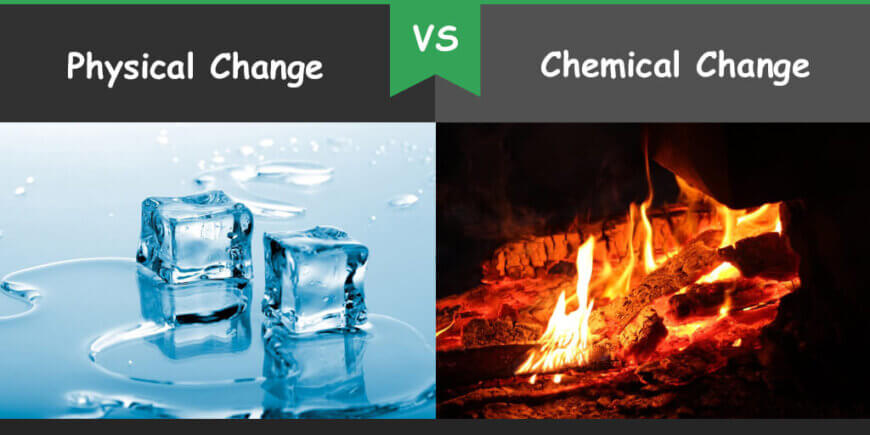A change that does not produce a new substance after the reaction is called the physical change whereas A change that forms a new substance after the reaction is called the chemical change. The main difference between physical and chemical change lies in the chemical composition. Chemical Change involves the change in chemical composition which eventually forms a new substance whereas physical change does not change the chemical composition of the substance but brings the changes in the physical properties such as color, size, and shape, etc. Physical properties are usually color, shape, size, volume, mass, density, and chemical properties are boiling point, melting point, the heat of combustion, oxidation states, and coordination number, etc.

Change is the part of everyone’s life. Changes are not restricted to the chemical labs only but happen everywhere. All plants, animals, microorganisms and non-living things show changes. Some changes occur slowly while some changes occur abruptly. Changes occur basically in matter and matter is present everywhere. It is necessary to know about the differences between physical and chemical change to know about nature.
Contents
Comparison Chart
| Basis for Comparison | Physical Change | Chemical Change |
| Definition | Physical change can be defined as the rearrangement of molecules with no compositional change. | A chemical change can be defined as the compositional change of a substance with the formation of a new substance. |
| It affects | Physical properties (color, size, shape, etc.) | Physical and chemical properties |
| Type of change | Temporary change | Permanent change |
| Product | No new substance | New substance |
| Energy | No need or production of energy, evaporating alcohol, | Need or utilize of energy in the form of light, heat or sound |
| Type of reaction | Reversible reaction | Irreversible or reversible reaction |
| Examples | Melting of ice, Crumpling of aluminum foil sheet, breaking of a bottle, boiling water, casting silver in a mold, dissolving sugar in water, melting of wax, shredding of paper | Burning wood, souring milk, cooking an egg, baking cake, mixing acid and base, digesting food, heating sugar to form caramel, rusting of iron. |
What is Physical Change?
The reaction or change in which one form of a substance switch into another form without altering its chemical composition or properties is called physical change. It can be explained by taking an example of the everyday life of a sheet of paper. When the sheet of paper is torn into pieces, the paper just alters its shape and size but other properties remain the same. Another most common example is the transformation of water into water vapors or ice or melting of ice. All are forms of water with similar chemical properties. So the change in size, texture, and shape is called physical change.
Physical changes are usually reversible and temporary. Matters are interconvertible from one state to another state like solid, liquid or gas. Ice can be melted into liquid or water and then water can also be converted into ice by giving low temperatures. In a physical change, no or little energy change occurs.
What is Chemical Change?
A chemical change is just opposite to the physical change. In chemical change or reaction, a new type of substance is formed with new chemical or sometimes also of new physical properties. For instance, take the example of burning the paper or wood, after the reaction components of the substance changes and a new substance has formed. Chemical changes alter the properties of the matter during the reaction. Atoms and molecules rearrange themselves and a new substance has formed.
The chemical change is not easy to reverse. So chemical change is irreversible and permanent. Sometimes chemical changes not only alter the chemical properties but also physical properties such as taste, shape, color, etc. The formation of bubbles, the evolution of energy, change in color and temperature are some indications of chemical changes. In chemical reaction or change, the substances before the change are called reactants whereas the new substance formed is called products. Energy also changes in chemical change because of the formation of a new substance. Energy is either produced or consumed in chemical changes. Some chemical changes are adding vinegar to baking soda, fermenting of grapes and bleaching a stain.
Although thousands of chemical changes occur in daily life here two chemical changes combination and decomposition has been described. In combination, two or more substances are combined to form a new substance or compound. These kinds of reactions can be seen in the corrosion of metals. Decomposition is another type of chemical change in which a substance breaks down into two or more types. It can be seen in the decomposition of fruits over time. It also occurs when a substance absorbs energy for instance when water decomposes into hydrogen and oxygen with the help of electricity.
Key Differences between Physical and Chemical Change
- In a physical change, no new substance is formed whereas, in chemical change, a new substance is formed.
- In physical substance, the chemical composition remains the same whereas, in chemical change, the chemical composition is changed.
- Physical change can be temporary whereas chemical change can be permanent.
- In physical reaction, the reaction is reversible whereas, in chemical change, the reaction is reversible or irreversible.
- In a physical change, no energy is produced whereas, in a chemical reaction, energy is produced in the form of heat, light or sound.
- The physical change affects physical properties such as size, shape, and color whereas chemical change affects both physical and chemical change.
Conclusion
In conclusion, both physical and chemical changes occur everywhere. Both can be differentiated from each other on the change of chemical composition and physical characteristics. In a physical change, physical properties change whereas, in chemical change, the chemical composition also changes.